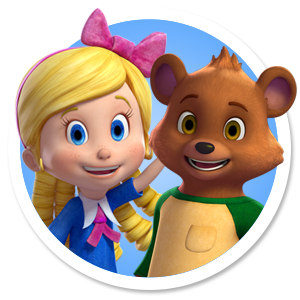
For new viewers and readers, Goldie and Bear is Disney Junior’s latest fairy tale-themed television show. It’s cute and clever and computerized-cuddly. The season premiere confirmed that this show could prove its mettle. And most wonderfully, this second episode bought my viewership by showcasing my obsession, the one and only Little Red Riding Hood!
Goldie and Bear has a greater commitment to storytelling and fairy tales than one would expect from a show for youngsters. To better analyze this intellectual storytelling, I’ve chosen two approaches to review: first, distilling the themes that really mattered in the tale; and second, the episode’s accessibility to children.
MINING WHAT MATTERED
Both storylines in this double episode feature clothing, strangely enough, and clothing’s necessary “fit.” The emphasis on the latter was a nice throwback to the “Goldilocks and the Three Bears” tale, where “fit” is king. Too big? Too hot? Too soft? Just right?
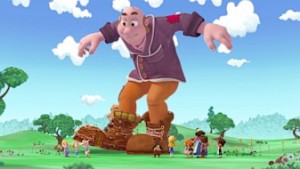
In the first storyline, “Fee Fi Fo Shoe,” Goldie and Bear are playing Buttercup Ball (a type of field hockey played with giant buttercups) when a giant’s shoe falls from the sky and crashes into their field. The bad news? Now Goldie and Bear can’t play Buttercup Ball in that field. The good news—there’s a giant missing his shoe (which is a nice continuity from a throwaway scene from the last episode, which shows Jack fleeing the beanstalk). But worse news is just around the corner: Mrs. Old Woman and her horde of children have filled the shoe’s new vacancy, and her life rule is “Finders, Keepers”.
Goldie and Bear convince the Giant to just exchange the shoe for another object that could house Mrs. Old Woman (who now Lives in the Shoe). He tries a colander, but Mrs Old Woman objects, for what if it rains? A teapot meets a similar fate, for how can her children climb through the little spout? The same happens with a hat, a birdcage, a watering can, and a cake. Much like with “Goldilocks and the Three Bears,” there’s a lot of trial and error until the perfect fit, which comes in a surprise twist for both Mrs. Old Woman and the Giant.
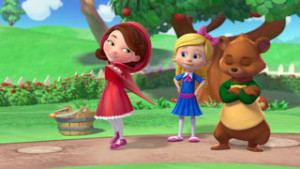
In the second storyline, “Little Gold Riding Hood” (and I admit I squealed at the opening credits), Goldie covets Little Red’s magnificent scarlet hood. “I’ve always wanted to wear her hood,” she says. “It’s so beautiful and RED!” However, Little Red, a massive clean freak who could put Friend’s Monica to shame, never lets anyone borrow her hood on the chance it could get dirty. Luckily for Goldie, Little Red really wants to visit Rapunzel but must take a basket of muffins to her Granny. Goldie volunteers for the task in exchange for the red hood, but Bear has to vouch for the dirt-prone Goldie before any deal is made. Oh, and one small detail—keep watch for the big bad wolf. He’s always trying to get the basket of muffins.
It’s not long before Goldie’s new look is more trouble than it’s worth (it seems the cloak is redder on the other side). With the Big Bad Wolf on the prowl, there are traps of dirt, tar, and muddy water. What’s really interesting, however, is how the Big Bad Wolf’s plans also emphasize “fit” and “rightness.” This ties back to the Grimms’ version of “Little Red Riding Hood,” where the wolf is taken with masquerading (by pretending to be both Little Red and the Grandmother, respectively). Here, in place of Grandmother’s nightie, the Big Bad Wolf dresses up in a Humpty Dumpty suit, but this is also a bad fit. In the end, both Big Bad Wolf and Goldie discover that their own selves “suit” them best after all.
AUDIENCE ACCESSIBILITY
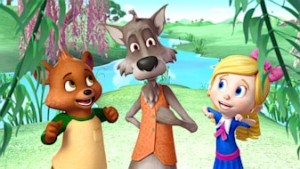
In the last two episodes, the Big Bad Wolf has made a significant appearance, which I expect to only grow over the season. He’s far more sanitized than written tale or oral tale would suggest. Instead of lusting over Little Red’s lean muscle, he salivates over Granny’s muffins, which is a parent and kid-friendly move for Disney Junior. Kids will likely latch onto the Big Bad Wolf—he’s really the awkward kid who just doesn’t know how to make a friend (or ask politely). When asked, “What’s the magic word?” (It’s “please”), the Big Bad Wolf hems and haws: “Abracadabra, Hocus Pocus, Alacazam, alright, fine, PLEASE.” He’s even given a catchphrase for when he makes a quick getaway from his mischief: “Gotta mambo!” The Big Bad Wolf’s inclusion in the show allows for a “villain” that is not too scary or too bad…a fairy tale “gateway” villain, if you will.
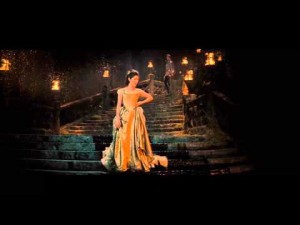
And for the adults, there are a few almost-allusions working in the episode. In “Little Gold Riding Hood,” when the Big Bad Wolf tries to grab the basket of muffins, Bear does a cleaning check on the Big Bad Wolf that is eerily similar to Disney’s Snow White’s (1937) famous “Hands!” inspection. And later, the Big Bad Wolf sets a trap for Little Red Riding Hood that consists of spreading the path with tar. Fairy tale lovers will recognize this as homage to the Grimms’ version of Cinderella, where the Prince spreads pine tar over the steps to halt Cinderella’s retreat. Or perhaps modern audiences will relate the spread of tar more to Rob Marshall’s 2014 film, Into the Woods.
Fairy tale and storybook characters appearing/referenced in “Goldie and Bear” 1.2:
- Goldilocks, Bear, Jack, Jack and Jill, Humpty Dumpty, the Giant, Old Woman who Lived in a Shoe, Little Red Riding Hood, the Big Bad Wolf, Rapunzel, and the Grandmother
I am disappointed by the Goldie and Bear episode, “Fee Fi Fo Shoe.” By using the school bully mantra of “finder’s keepers”, it teaches children that stealing is acceptable as long as someone has taken their eye off of their possession. Why not teach instead to be gracious by returning the giants shoe, then working together to find the old woman a new home?